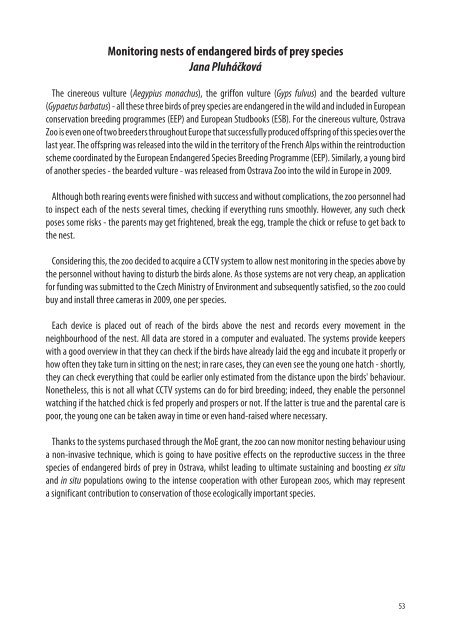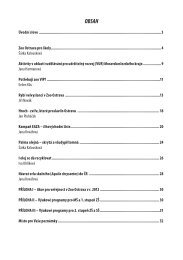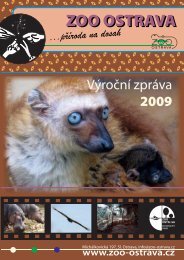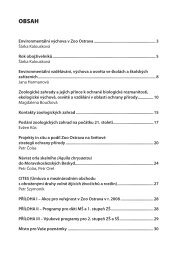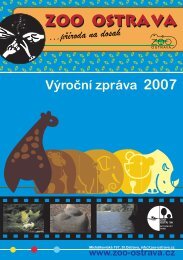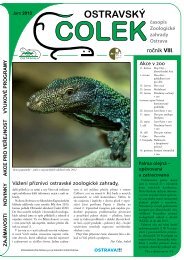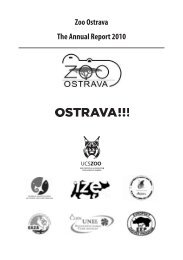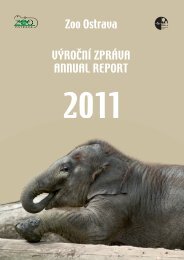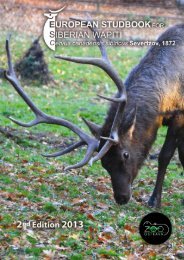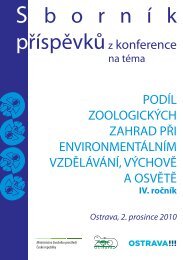Create successful ePaper yourself
Turn your PDF publications into a flip-book with our unique Google optimized e-Paper software.
Monitoring nests of endangered birds of prey species<br />
Jana Pluháčková<br />
<strong>The</strong> cinereous vulture (Aegypius monachus), the griffon vulture (Gyps fulvus) and the bearded vulture<br />
(Gypaetus barbatus) - all these three birds of prey species are endangered in the wild and included in European<br />
conservation breeding programmes (EEP) and European Studbooks (ESB). For the cinereous vulture, <strong>Ostrava</strong><br />
<strong>Zoo</strong> is even one of two breeders throughout Europe that successfully produced offspring of this species over the<br />
last year. <strong>The</strong> offspring was released into the wild in the territory of the French Alps within the reintroduction<br />
scheme coordinated by the European Endangered Species Breeding Programme (EEP). Similarly, a young bird<br />
of another species - the bearded vulture - was released from <strong>Ostrava</strong> <strong>Zoo</strong> into the wild in Europe in <strong>2009</strong>.<br />
Although both rearing events were finished with success and without complications, the zoo personnel had<br />
to inspect each of the nests several times, checking if everything runs smoothly. However, any such check<br />
poses some risks - the parents may get frightened, break the egg, trample the chick or refuse to get back to<br />
the nest.<br />
Considering this, the zoo decided to acquire a CCTV system to allow nest monitoring in the species above by<br />
the personnel without having to disturb the birds alone. As those systems are not very cheap, an application<br />
for funding was submitted to the Czech Ministry of Environment and subsequently satisfied, so the zoo could<br />
buy and install three cameras in <strong>2009</strong>, one per species.<br />
Each device is placed out of reach of the birds above the nest and records every movement in the<br />
neighbourhood of the nest. All data are stored in a computer and evaluated. <strong>The</strong> systems provide keepers<br />
with a good overview in that they can check if the birds have already laid the egg and incubate it properly or<br />
how often they take turn in sitting on the nest; in rare cases, they can even see the young one hatch - shortly,<br />
they can check everything that could be earlier only estimated from the distance upon the birds' behaviour.<br />
Nonetheless, this is not all what CCTV systems can do for bird breeding; indeed, they enable the personnel<br />
watching if the hatched chick is fed properly and prospers or not. If the latter is true and the parental care is<br />
poor, the young one can be taken away in time or even hand-raised where necessary.<br />
Thanks to the systems purchased through the MoE grant, the zoo can now monitor nesting behaviour using<br />
a non-invasive technique, which is going to have positive effects on the reproductive success in the three<br />
species of endangered birds of prey in <strong>Ostrava</strong>, whilst leading to ultimate sustaining and boosting ex situ<br />
and in situ populations owing to the intense cooperation with other European zoos, which may represent<br />
a significant contribution to conservation of those ecologically important species.<br />
53


